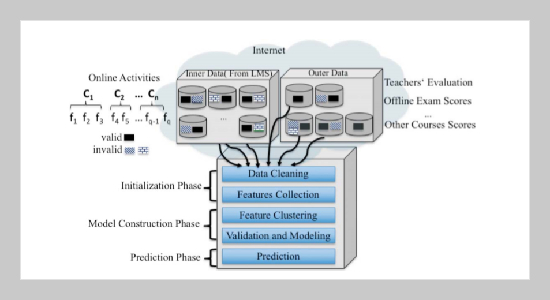REFERENCES
- [1] Goldberg, D. E. and Holland, J. H., “Genetic Algorithms and Machine Learning,” Machine Learning, Vol. 3,No. 2,pp. 95�99(1988). doi:10.1007/BF00113892
- [2] Witten, I. H., Frank, E., Hall, M. A., et al., Data Mining: Practical Machine Learning Tools and Techniques,4 th ed., Morgan Kaufmann, Boston, pp. 7�9 (2016).
- [3] Mcauley, A., Stewart, B., Cormier, D., et al., The MOOC Model for Digital Practice (2010).
- [4] Fox, A., “From MOOCs to SPOCs,” Communications of the Acm, Vol. 56, No. 12, pp. 38�40 (2013). doi: 10. 1145/2535918
- [5] Siemens, G. and d Baker, R. S. J., “Learning Analytics and Educational Data Mining: Towards Communication and Collaboration,” Proc. of the 2nd International Conference on Learning Analytics and Knowledge, Vancouver, Canada, April 29�May 02, pp. 252�254 (2012).
- [6] Peña-Ayala,A., “Learning Analytics: aGlance of Evolution, Status, and Trends According to a Proposed Taxonomy,”Wiley Interdisciplinary Reviews Data Mining & Knowledge Discovery, Vol. 8, No. 3, pp. 1�29 (2018). doi: 10.1002/widm.1243
- [7] Baltrušaitis, T., Ahuja, C. and Morency, L. P., “Multimodal Machine Learning: a Survey and Taxonomy,” IEEE Transactions on Pattern Analysis &Machine Intelligence, pp. 1�20 (2018). doi: 10.1109/TPAMI.2018. 2798607
- [8] Klaus, G., et al., “LSTM: a Search Space Odyssey,” IEEE Transactions on Neural Networks and Learning Systems,” Vol. 28, No. 10, pp. 2222�2232 (2017). doi: 10.1109/TNNLS.2016.2582924
- [9] Qiu, J., Wu, Q., Ding, G., et al., “ASurvey of Machine Learning for Big Data Processing,” Eurasip Journal on Advances in Signal Processing, Vol. 67 (2016). doi: 10.1186/s13634-016-0355-x
- [10] Simon,P.,Too Big to Ignore: the Business Case for Big Data, Wiley, New Jersey, pp. 2�5 (2013).
- [11] Ghaffarian, S. M. and Shahriari, H. R., “Software Vulnerability Analysis and Discovery Using Machine learning and Data-mining Techniques: a Survey,” Acm Computing Surveys, Vol. 50, No. 4, pp. 1�36 (2017). doi: 10.1145/3092566
- [12] Buczak, A. L. and Guven, E., “A Survey of Data Mining and Machine Learning Methods for Cyber Security Intrusion Detection,” IEEE Communications Surveys & Tutorials, Vol. 18, No. 2, pp. 1153�1176 (2017). doi: 10.1145/3092566
- [13] Dipnall, J. F., Pasco, J. A., Berk, M., et al., “Fusing Data Mining, Machine Learning and Traditional Statistics to Detect Biomarkers Associated with Depression,” Plos One, Vol. 11, No. 2 (2016). doi: 10.1371/ 0148195
- [14] Picciano, A. G., “The Evolution of Big Data and Learning Analytics in American Higher Education,” Journal of Asynchronous Learning Networks, Vol. 16, No. 3, pp. 9�20 (2012).
- [15] Ludgate, H., “NMC Horizon Report: 2013 Higher Education Edition,” Austin, Texas: The New Media Consortium (2013).
- [16] Johnson, L., Adams Becker, S., Cummins, et al., “NMC Horizon Report: 2016 Higher Education Edition, Austin, Texas: The New Media Consortium (2016).
- [17] Shapiro, H. B., Lee, C. H., Roth, N. E. W., et al., “Understanding the Massive Open Online Course (MOOC) Student Experience,” Computers & Education, Vol. 110, pp. 35�50 (2017). doi: 10.1016/j.compedu.2017. 03.003
- [18] Jiang, Q., Zhao, W., Wang, P. J., et al., “Realization of Individual Adaptive Online Learning Analysis Model Based Big Data,” China Educational Technology, Vol. 336, pp. 85�92 (2015).
- [19] Wong, J. S., Pursel, B.,Divinsky, A., etal.,“An Analysis of MOOC Discussion Forum Interactions from the Most Active Users,” Proc. of Social Computing, Behavioral-Cultural Modeling, and Prediction, WashingtonDC,USA, March31�April3,pp. 452�457 (2015).
- [20] Smith, M. K., Wood, W. B., Adams, W. K., et al., “Why Peer Discussion Improves Student Performance on In-Class Concept Questions,” Science, Vol. 323, No. 5910, pp. 122�124 (2009). doi: 10.1126/science.1165919
- [21] Breslow, L., Pritchard, D. E., Deboer, J., et al., “Studying Learning in the Worldwide Classroom Research into edX’s First MOOC,” Research & Practice in Assessment, Vol. 8, pp. 13�25 (2013).
- [22] Viswanath Venkatesh, H. B. “Technology Acceptance Model 3 and a Research Agenda on Interventions,” Decision Sciences,Vol.39, No. 2,pp. 273�315 (2008). doi: 10.1111/j.1540-5915.2008.00192.x
- [23] Wang, Z., A Study of the Key Inouential Factors on Effect of E-learning, Master Dissertation, East China Normal University, Shanghai, China (2007).
- [24] Tan, G. X., Xu, F. and Qu, W. J., “Influential Factors and Models of Online Teaching Behavior Intention of University Students,” E-Education, Research, Vol. 34, No. 1, pp. 47�53 (2012).
- [25] Li,D., Li,X. and Shao, P, “Studying on theFactors Related to Learning Success in Mixed Web Based Learning Environment,” China Journal of Information Systems, (2011).
- [26] Haney, C. L., Atiq, S. Z., DeBoer, J. and Cox, D., “Comparing Different Learning Activities in a Global Neuroscience MOOC,” Proc. Of ASEE‘s 123rd Annual Conference and Exposition, New Orleans, LA, June 26�29 (2016).
- [27] Zhao, Z., Wu, Q., Chen, H. and Wan, C., “Learning Quality Evaluation of MOOC Based on Big Data Analysis,” Proc. of International Conference on Smart Computing and Communication, Springer, Cham, December, pp. 277�286 (2016).
- [28] Saberi, N. and Montazer, G. A., “ANew Approach for Learners’Modeling in E-learning Environment Using LMS Logs Analysis,” Proc. of 2012 Third International Conference on E-Learning and E-Teaching (ICELET), Tehran, Iran, Feb. 14�15, pp. 25�33 (2012).
- [29] Khalil, M. and Ebner, M., “Clustering Patterns of Engagement in Massive Open Online Courses (MOOCs): the Use of Learning Analytics to Reveal Student Categories,” Journal of Computing in Higher Education, Vol. 29, No. 1, pp. 1�19 (2017). doi: 10.1007/s12528016-9126-9
- [30] Wu, Q. and Luo, R., “Predicting the Students’ Performances and Reflecting the Teaching Strategies Based on the E-Learning Behaviors,” Modern Educational Technology, Vol. 27, No. 6, pp. 18�24 (2017). doi: 10. 3969/j.issn.1009-8097.2017.06.003
- [31] You, J. W., “Identifying Significant Indicators Using LMS Data to Predict Course Achievement in Online Learning,” Internet & Higher Education, Vol. 29, p. 2330 (2016). doi: 10.1016/j.iheduc.2015.11.003
- [32] Information on https://jasp-stats.org/.2018-3-22.
- [33] Keefe, J. W., School Applications of the Learning Style Concept: Student Learning Styles, Reston, VA: National Association of Secondary School Principals, Vol. 44 (1979). [34] Kinsella, K., “Understanding and Empowering Diverse Learners in the ESL Classroom,” Learning Styles in the ESL/EFLClassroom, pp. 170�194 (2002).
















